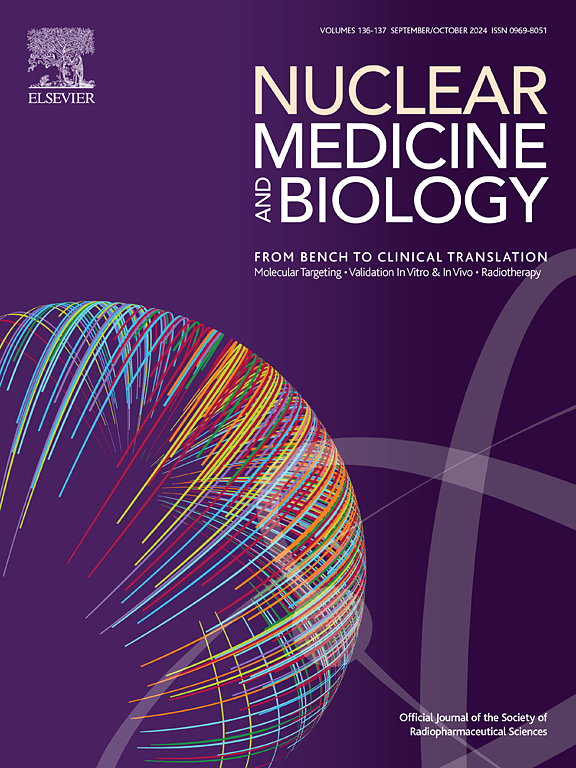First-in-human healthy volunteer dosimetry studies of the excitatory amino acid transporter 2 (EAAT2) PET imaging tracer methyl N4-(7-[18F]fluoro-9H-fluoren-2-yl)asparaginate, [18F]RP-115
IF 3.6
4区 医学
Q1 RADIOLOGY, NUCLEAR MEDICINE & MEDICAL IMAGING
引用次数: 0
Abstract
Objective and background
The objective of this first-in-human study was to investigate the radiosynthesis, and the preliminary safety, biodistribution, and organ radiation dosimetry of the positron emission tomography (PET) imaging tracer methyl N4-([18F]7-fluoro-9H-fluoren-2-yl)asparaginate, known as [18F]RP-115, in a small cohort (n=8) of healthy volunteers. The [18F]RP-115 tracer is a methyl ester prodrug and undergoes metabolic saponification in the central nervous system to generate the corresponding carboxylic acid form that selectively binds to the excitatory amino acid transporter 2 (EAAT2) protein.
Procedures and methods
A multi-step high molar activity tracer radiosynthesis was devised to produce doses. Eight healthy human participants (four male and four female), aged 56–75, received a bolus intravenous injection of [18F]RP-115 (administered activity range: 70.3–355 MBq) prior to a total of 94 min of PET-MR scanning performed as three sequential scanning sessions. Regional tissue volumes of interest were defined, time-integrated activity coefficients (TIAC) were derived, and then estimates of organ and tissue activities and effective doses (whole body) were calculated, with two versions of OLINDA software (1.1 and 2.0) that incorporated two tissue weighting factor sets (ICRP-60 and -103), respectively.
Main findings
Tracer was routinely produced in good radiochemical yields and as suitable high molar activity doses for injection. The [18F]RP-115 injections and PET-MR scans were well-tolerated and no adverse events were reported (≤48 h). Radioactivity was widely biodistributed with good organ uptake. TIACs and estimated radiation organ doses were determined, for which a few statistically significant estimated organ dose differences between males and females were noted. The kidneys were identified as the critical target organ.
Principal conclusions
Injection of [18F]RP-115 was considered safe. The estimated kidney radiation doses relative to administered radioactivity identified a more optimal human [18F]RP-115 tracer injected amount of <211 MBq. This more optimal [18F]RP-115 tracer injected activity definition is similar to the amounts used for other established [18F]labeled clinical PET tracers such as [18F]FDG, and it will be used in future RP-115 clinical PET imaging studies.

兴奋性氨基酸转运体2 (EAAT2) PET显像示踪剂甲基N4-(7-[18F]氟- 9h -氟-2-基)天冬酰胺,[18F]RP-115的首次人体健康志愿者剂量学研究
这项首次人体研究的目的是研究正电子发射断层扫描(PET)成像示踪剂甲基N4-([18F]7-氟- 9h -氟-2-基)天冬酰胺(称为[18F]RP-115)在一小群健康志愿者(n=8)中的放射性合成、初步安全性、生物分布和器官辐射剂量学。[18F]RP-115示踪剂是一种甲酯前药,在中枢神经系统中经过代谢皂化产生相应的羧酸形式,选择性结合兴奋性氨基酸转运蛋白2 (EAAT2)。设计了多步高摩尔活度示踪剂放射性合成方法。8名健康受试者(4男4女),年龄56-75岁,在共94分钟的PET-MR扫描前接受静脉注射[18F]RP-115(给药活性范围:70.3-355 MBq)。定义感兴趣的区域组织体积,导出时间积分活度系数(TIAC),然后使用两个版本的OLINDA软件(1.1和2.0)计算器官和组织活度和有效剂量(全身),分别包含两个组织加权因子集(ICRP-60和-103)。主要发现示踪剂的常规生产具有良好的放射化学产率和合适的高摩尔活性剂量注射。[18F]RP-115注射和PET-MR扫描耐受性良好,无不良事件报告(≤48小时)。放射性广泛生物分布,器官摄取良好。确定了TIACs和估计的辐射器官剂量,其中注意到男性和女性之间有一些统计上显著的估计器官剂量差异。肾脏被认为是关键的靶器官。主要结论注射[18F]RP-115是安全的。相对于给药放射性的估计肾脏辐射剂量确定了更理想的人体[18F]RP-115示踪剂注射量为211 MBq。这种更优的[18F]RP-115示踪剂注射活性定义与其他已建立的[18F]标记的临床PET示踪剂(如[18F]FDG)的用量相似,并将用于未来的RP-115临床PET成像研究。
本文章由计算机程序翻译,如有差异,请以英文原文为准。
求助全文
约1分钟内获得全文
求助全文
来源期刊

Nuclear medicine and biology
医学-核医学
CiteScore
6.00
自引率
9.70%
发文量
479
审稿时长
51 days
期刊介绍:
Nuclear Medicine and Biology publishes original research addressing all aspects of radiopharmaceutical science: synthesis, in vitro and ex vivo studies, in vivo biodistribution by dissection or imaging, radiopharmacology, radiopharmacy, and translational clinical studies of new targeted radiotracers. The importance of the target to an unmet clinical need should be the first consideration. If the synthesis of a new radiopharmaceutical is submitted without in vitro or in vivo data, then the uniqueness of the chemistry must be emphasized.
These multidisciplinary studies should validate the mechanism of localization whether the probe is based on binding to a receptor, enzyme, tumor antigen, or another well-defined target. The studies should be aimed at evaluating how the chemical and radiopharmaceutical properties affect pharmacokinetics, pharmacodynamics, or therapeutic efficacy. Ideally, the study would address the sensitivity of the probe to changes in disease or treatment, although studies validating mechanism alone are acceptable. Radiopharmacy practice, addressing the issues of preparation, automation, quality control, dispensing, and regulations applicable to qualification and administration of radiopharmaceuticals to humans, is an important aspect of the developmental process, but only if the study has a significant impact on the field.
Contributions on the subject of therapeutic radiopharmaceuticals also are appropriate provided that the specificity of labeled compound localization and therapeutic effect have been addressed.
 求助内容:
求助内容: 应助结果提醒方式:
应助结果提醒方式:


